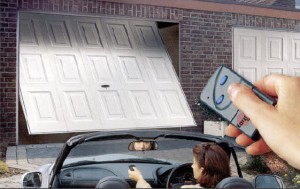Improperly operating automatic reversing mechanisms on garage door openers have been linked to many injuries and even deaths. The weight and pressure involved in closing a garage door can cause serious injury to someone in the path of the door, especially children.
What Is A “Reversing Mechanism?”
You’ve probably seen this little gadget in action and didn’t give it much thought, or maybe you have even been annoyed by its efficiency, like when you think you have closed the garage, only to find out later that the door was open all night because a large stick caused the door to reverse back open. But as you may have already guessed, the garage door reversing mechanism is extremely important. It is the component that allows the door to quickly reverse if it encounters an obstacle, like a stick–but much more importantly, like a child.
There are commonly two parts to this safety system. First, the opener motor senses resistance, and will reverse its direction if a certain amount of resistance is met. As a backup to this system, there are usually two infrared sensors mounted six inches above the floor at the garage door frame. If any object is blocking the path of the infrared sensors, the garage door opener will not activate.
Not every garage door opener has an automatic reversing mechanism. In 1982, a voluntary industry standard (ANSI-UL 325-1982) was created, requiring automatic reversing mechanisms on garage door openers sold in the United States. Some pre-1982 garage door openers were manufactured with other safety features which may stop the door, but not cause it to reverse. Since most pre-1982 garage door openers do not comply with current safety standards, the Consumer Product Safety Commission (CPSC) recommends replacement with one that has an auto-reversing feature and meets current standards.
How to Test Auto Reverse Mechanism
A common method of testing the reversing mechanism involves placing a roll of paper towels under the path of the door. If the door causes the cardboard tube in the paper towels to bend, it requires too much force to reverse. (By the way, if an excessive amount of pressure is required to cause the door opener to reverse, the reversing mechanism is considered “inoperable”). The CPSC suggests testing the reversing mechanism with a 2×4 piece of wood or a 2-inch block. Place the 2×4 or 2-inch block on the floor under the door. If it does not reverse immediately after striking the wood, it requires too much force to reverse. The CPSC recommends testing the garage door opener reversing mechanism every month. If the reversing mechanism fails, the door opener should be disconnected until it is repaired.
Repairing A Reversing Mechanism
Correcting an inoperable reversing mechanism varies greatly depending on the model and age of the door opener. It may be as simple as a couple twists with a screwdriver, or it may be serious enough to require replacement of the garage door opener. The owner’s manual for the garage door opener provides information about adjusting the reversing mechanisms. If the correction of the reversing mechanism is more complicated than a simple adjustment, contact a competent garage door service company.






